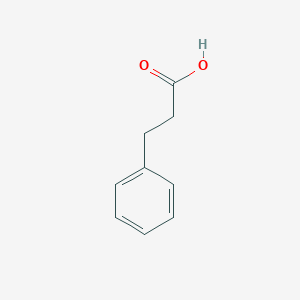| General Information of MET (ID: META00320) |
| Name |
Hydrocinnamic acid
|
| Synonyms |
Click to Show/Hide Synonyms of This Metabolite
3-Phenyl propionic acid; 3-Phenyl-N-propionate; 3-Phenyl-N-propionic acid; 3-Phenyl-propionate; 3-Phenyl-propionic acid; 3-Phenylpropanoate; 3-Phenylpropanoic acid; 3-Phenylpropionate; 3-Phenylpropionic acid; 3-Phenylpropionic acid, sodium salt; 3-Phenylpropionsaeure; 3PP; Benzenepropanoate; Benzenepropanoic acid; Benzenepropionate; Benzenepropionic acid; Benzylacetate; Benzylacetic acid; Dihydrocinnamate; Dihydrocinnamic acid; HYDROCINNAMIC ACID; Hydrocinnamate; Hydrozimtsaeure; Omega-phenylpropanoate; Omega-phenylpropanoic acid; Phenylpropanoate; Phenylpropanoic acid; Phenylpropionic acid; W-Phenylpropanoate; W-Phenylpropanoic acid; b-Phenylpropionate; b-Phenylpropionic acid; beta-Phenylpropionic acid
|
| Source |
Endogenous;Drug Metabolite;Escherichia Coli Metabolite;Food;Drug;Food additives;TCM Ingredients;Microbial
|
| Structure Type |
Phenylpropanoic acids (Click to Show/Hide the Complete Structure Type Hierarchy)
Phenylpropanoids and polyketides
Phenylpropanoic acids
|
| PubChem CID |
|
| HMDB ID |
|
| Formula |
C9H10O2
|
| Structure |
<iframe style="width: 300px; height: 300px;" frameborder="0" src="https://embed.molview.org/v1/?mode=balls&cid=107"></iframe>
|
 |
|
3D MOL
|
2D MOL
|
|
Click to Show/Hide the Molecular/Functional Data (External Links/Property/Function) of This Metabolite
|
| KEGG ID |
|
| DrugBank ID |
|
| ChEBI ID |
|
| FooDB ID |
|
| ChemSpider ID |
|
| METLIN ID |
|
| Physicochemical Properties |
Molecular Weight |
150.17 |
Topological Polar Surface Area |
37.3 |
| XlogP |
1.8 |
Complexity |
126 |
| Heavy Atom Count |
11 |
Rotatable Bond Count |
3 |
| Hydrogen Bond Donor Count |
1 |
Hydrogen Bond Acceptor Count |
2 |
| Function |
Hydrocinnamic acid, also known as phenylpropanoic acid, is an analogue of phenylalanine. It is a substrate of the enzyme oxidoreductases (EC 1.14.12.-) in the pathway phenylalanine metabolism (KEGG). Hydrocinnamic acid is a microbial metabolite and it can be found in Clostridium and Eubacterium. It is a marker for the presence of Clostridium sporogenes in the gut. Higher levels are associated with higher levels of Clostridium sporogenes. Hydrocinnamic acid is detected after the consumption of whole grain.
|
|
Regulatory Network
|
|
|
|
|
|
|
|
|
 click to show the details of this protein
click to show the details of this protein
 click to show the details of experiment for validating this pair
click to show the details of experiment for validating this pair

